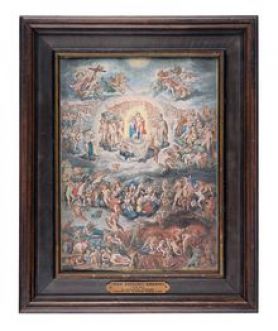The Last Judgment, after Michelangelo

In the late 16th and early 17th centuries, there developed in Strasbourg what may be considered as a school of miniature painting. The works were particularly appreciated by collectors, who bought them to adorn their curiosity cabinets. The leading figure in this school was Friedrich Brentel, who developed the habit of using engravings as a basis for his miniatures. This is his interpretation of one of the most famous works of the Renaissance, Michelangelo's Last Judgement. Never having been to Italy however, he had not been able to see it directly. Instead, he made do with an engraving in his possession and allowed himself the freedom of choosing colours that suited him. Although it is only 15 3/4 inches in height, the painting is considered to be his largest work. This can give us some idea of the miniature formats he favoured during his career.
